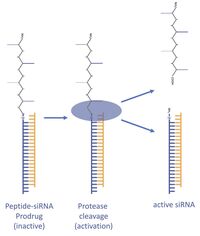
Dr. Tobias Pöhlmann
Ronneburger Straße 74
07546 Gera
info@xnapharma.com
https://xnapharma.com
Oligonucleotide-based therapies face several major hurdles: delivery into target cells and side effects in non-target organs - especially the liver. Furthermore, stability in serum as well as cost efficient GMP manufacturing are challenges that are essential to be solved for clinical development.
XNApharma with its long history in siRNA drug development and oligonucleotide manufacturing as well as with its wide scientific and clinical network is addressing all of the mentioned topics in order to provide a fast and stremlined preclinical and clinical pipeline.
Our core technology is a peptide-inhibited siRNA prodrug that is selectively activated in target cancer cells by specific protease. By using this strategy, side effects in non-target cells can be prevented.
Peptide-siRNA drug design
XNApharmas oligonucleotide core design is a chemically modified siRNA sequence containing an inhibiting peptide via a linker at the 5`end of the antisense guide strand. Both strands contain 3` phosphorthioate modifications and represent standard siRNA design elements as well as proprietary aspects.
siRNA activation in target cells
Peptide-siRNA-Prodrugs are delivered into a variety of cells as a biologically non-active prodrug. The prodrug design provides a selective activation in target cells, whereas in non-target cells, the Peptide-siRNA is simply degraded by nucleases.
Activation occurs by cleavage of the inhibiting peptide from the siRNA prodrug leading to its activation. This cleavage is induced by proteases that show a specific activity in target cells. Target cells can be cells infected by a virus, carrying a virus protease or cancer cell displaying a specific protease expression/activity pattern.
By using Peptide-siRNA-Prodrug technology, side effects of siRNA based APIs due to organ overload can be prevented.
Peptide-siRNA-Prodrug - a unique platform for delivery
For activation, the inhibiting peptide must be cleaved from the siRNA. This peptide can be the linker to couple additional structures to siRNA in order to induce a better cell specifity, biodistribution, and cellular delivery.
Examples of bound structures for delivery could be GalNAc conjugates, cell penetrating peptides, aptamers, polymers or others. Since the structures are cleaved from the siRNA during activation, there are fewer limitations regarding size, charge or hydrophobicity of the delivery structures compared to standard design strategies.
© XNApharma GmbH, Ronneburger Straße 74, 07546 Gera
Source: https://xnapharma.com/Technology_Platform

 Copyright© XNApharma GmbH
Copyright© XNApharma GmbH





